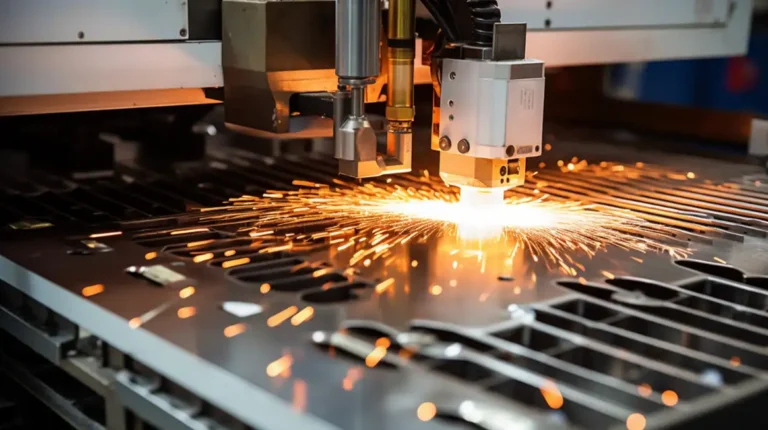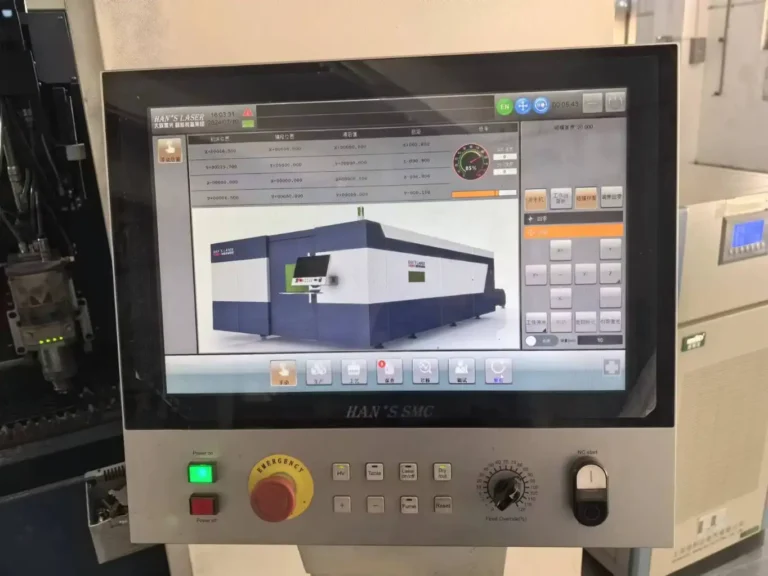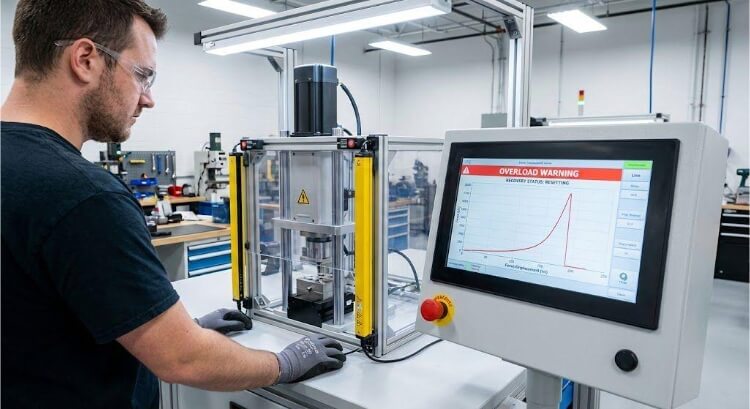Customers often need help with things such as slow turnaround times and high costs associated with traditional cutting methods. Traditional methods often need to catch up, leading to increased costs and wasted materials. To solve these issues, we offer laser cutting, which is faster and more precise.
Sheet metal laser cutting offers a precise and efficient way to cut metal. It uses a high-powered laser beam to slice through various types of sheet metal, ensuring clean and accurate cuts every time.
It’s an innovative process that can transform your manufacturing capabilities. Let’s explore how it works and why it’s beneficial.
Basics of Sheet Metal Laser Cutting
Defining Sheet Metal Laser Cutting: What It Is and How It Works
Sheet metal laser cutting is a process where a high-powered laser beam is cut through various types of sheet metal. The laser melts, burns, or vaporizes the material, creating precise and intricate cuts. Controlled by a computer, the laser follows a pre-determined path, ensuring accuracy and efficiency in producing prototypes and mass-production parts.
Types of Lasers Used in Metal Cutting
Fiber Lasers
Fiber lasers are known for their efficiency and high-quality output. They are ideal for cutting thin to medium-thickness metals, offering fast cutting speeds and low maintenance. Fiber lasers are particularly effective for high-reflectivity materials like aluminum and copper.
CO2 Lasers
CO2 lasers are versatile and can cut through various materials, including non-metals. They are best suited for thicker materials and are known for their smooth and precise cuts. CO2 lasers are commonly used in applications requiring high power and precision.
Nd: YAG Lasers
YAG Lasers are solid-state lasers with high peak power and can cut through very thick materials. They are less common in sheet metal cutting but are used in specialized applications requiring deep penetration and high precision.
Materials Suitable for Laser Cutting
Stainless Steel
Stainless steel is a popular material for laser cutting due to its strength, durability, and resistance to corrosion. It is used in various industries, including automotive, aerospace, and medical devices.
Aluminum
Aluminum is lightweight and has excellent corrosion resistance, making it suitable for various applications. Laser-cutting aluminum requires careful control of the laser settings to prevent burrs and achieve clean cuts.
Copper and Brass
Copper and brass are highly reflective materials that can be challenging to cut with traditional methods. However, the correct laser technology, such as fiber lasers, can cut these metals with high precision and minimal material wastage.
Technical Aspects of Laser Cutting
The Mechanics of Laser Cutting Machines
Laser cutting machines have several vital components that achieve precise cuts. The main parts include the laser resonator, a series of mirrors and lenses to direct the laser beam, a CNC controller to guide the cutting path, and a cutting bed to support the material.
Understanding the Laser Cutting Process
Laser Generation
The laser-cutting process begins with the generation of the laser beam. This beam is produced in the laser resonator, where an electrical discharge or diode excites this gas mixture (in the case of CO2 lasers) or a fiber optic cable (for fiber lasers). The energy from this excitation causes the gas or fiber to emit photons, creating a concentrated light beam.
Material Interaction
Once the laser beam is generated, it is directed through a series of mirrors and lenses to focus it onto the material’s surface. The high-intensity laser beam interacts with the material, causing it to melt, burn, or vaporize.
Cutting Mechanics
During cutting, the laser beam follows a pre-determined path controlled by the CNC system. The beam’s movement and the material’s response are finely tuned to achieve the desired cut. The process involves a combination of heating, melting, and material ejection, resulting in a clean and precise cut.
Critical Parameters in Laser Cutting
Power Settings
The power setting of the laser determines the amount of energy delivered to the material. Higher power settings are used for thicker materials, while lower power settings are suitable for thinner sheets.
Cutting Speed
Cutting speed refers to how fast the laser head moves across the material. The speed must be carefully balanced with the power setting to achieve clean cuts. Faster speeds may lead to incomplete cuts or rough edges, while slower speeds can cause excessive melting and material deformation.
Focus and Nozzle Adjustment
Proper focus ensures that the beam’s energy is concentrated on the material’s surface at the correct point. Adjusting the nozzle height and focus position allows for optimal cutting conditions, reducing the risk of defects and ensuring consistent quality.

Design Considerations for Sheet Metal Laser Cutting
Preparing Designs for Sheet Metal Laser Cutting
Software Tools and File Formats
When preparing sheet metal laser cutting designs, choosing software and file formats is crucial. Popular design software includes AutoCAD, SolidWorks, and Adobe Illustrator. These tools allow for precise vector-based designs. The most commonly used file formats for laser cutting are DXF (Drawing Exchange Format) and DWG (Drawing) files.
Design Tips for Optimal Cutting
To ensure optimal cutting results, consider the following design tips:
- Line Thickness: Use thin lines (usually hairline or 0.001 inches) for cut paths to ensure the laser follows the intended path without unnecessary material removal.
- Spacing: Maintain adequate spacing between cut lines to prevent material warping or overlap during cutting. A minimum spacing of the material’s thickness is a good rule of thumb.
- Kerf Consideration: Account for the laser’s kerf (width of the cut) in your design to ensure precise dimensions. The kerf varies based on the material and laser type, typically ranging from 0.1 to 0.3 mm.
- Simplify Designs: Avoid overly complex or intricate patterns that may be challenging for the laser to cut cleanly.
Impact of Design on Cut Quality and Precision
The design significantly influences the cut quality and precision of the laser cutting process. Well-prepared designs ensure the laser can follow the intended paths accurately, resulting in clean, precise cuts. Here are some key factors to consider:
- Accuracy: Detailed and accurate designs reduce the likelihood of errors during cutting. Ensure that all dimensions and measurements are precise to achieve the desired outcome.
- Material Consideration: Different materials respond differently to laser cutting. Design with the specific material in mind, considering its properties, such as thickness, melting point, and reflectivity.
- Cut Complexity: Simple, clean designs with smooth curves and minimal intricate details yield better results. Complex designs require slower cutting speeds and higher precision, potentially increasing production time and cost.
- Heat Affected Zone (HAZ): Minimize the heat-affected zone by designing with proper spacing and avoiding tight corners. Excessive heat can lead to material warping or discoloration, impacting the overall quality.
Advantages of Sheet Metal Laser Cutting
Precision and Accuracy
Sheet Metal laser cutting offers unparalleled precision and accuracy compared to traditional cutting methods. The laser beam’s narrow focus allows for excellent cuts with minimal material waste.
Speed and Efficiency
Laser cutting significantly outperforms traditional methods in terms of speed and efficiency. The high-speed movement of the laser beam, combined with its ability to cut through various materials quickly, reduces production times.
Versatility Across Materials and Thicknesses
One of the standout advantages of laser cutting is its versatility. It can handle various materials, including stainless steel, aluminum, and copper. Moreover, laser cutting can accommodate various material thicknesses, from thin sheets to thicker plates, without compromising cut quality.

Challenges and Solutions in Laser Cutting
Common Challenges in Laser Cutting Operations
Material Warping
Material warping occurs when the heat generated by the laser causes the material to deform. This is especially common with thin materials or metals with high thermal conductivity. Warping can lead to inaccuracies in the cut and affect the overall quality of the final product.
Dross Formation
Dross formation refers to the residue or slag left on the edge of the cut material. This occurs when the molten material solidifies on the edges rather than being blown away by the assist gas. Dross can affect the precision of the cut and require additional post-processing to remove.
Thermal Damage
Thermal damage includes discoloration, melting, or burning of the material around the cut area. This can compromise the appearance and structural integrity of the final product. It mainly concerns heat-sensitive materials, such as certain plastics or thin metals.
Advanced Techniques to Overcome Challenges
Pulse Cutting
Pulse cutting is an advanced technique that helps reduce thermal damage and improve cut quality. Instead of a continuous laser beam, pulse cutting uses short bursts of laser energy. This allows the material to cool slightly between pulses, minimizing heat buildup and reducing the risk of warping or thermal damage.
Cooling Systems
Cooling systems in the laser cutting process can effectively manage heat and prevent material deformation. Water-cooled laser heads and air or nitrogen assist gases help dissipate heat from the cutting area. These cooling measures maintain the material’s structural integrity and improve the overall quality of the cut.
Applications of Sheet Metal Laser Cutting
Industrial Applications
- Automotive Components
- Aerospace Parts
- Electronics and Enclosures
Artistic and Decorative Uses
- Custom Artwork
- Architectural Elements
Conclusion
Sheet metal laser cutting is a powerful and versatile technology. Its precision, speed, and ability to handle a wide range of materials make it an essential tool for modern manufacturing. We can optimize our processes by understanding the technology associated with laser cutting.
Do you need a reliable sheet metal parts manufacturer? Shengen is the place to go. We specialize in sheet metal laser cutting, bending, surface finish, and CNC Machining. Reach out to Shengen Today and seek help from professionals!
FAQs
What is the typical thickness range that laser cutters can handle?
Laser cutters can handle a wide range of material thicknesses, typically from as thin as 0.1 mm up to 25 mm, depending on the type of laser and the material being cut. CO2 lasers can cut up to around 20 mm for metals, while fiber lasers can efficiently cut materials up to 25 mm thick.
How does the type of laser affect the quality and speed of cutting?
The type of laser significantly impacts the quality and speed of cutting. Fiber lasers are generally faster and more efficient for cutting thin to medium-thickness metals and are especially effective on reflective materials like aluminum and copper. CO2 lasers provide high-quality cuts for thicker materials and a more comprehensive range of non-metallic materials.
What are the cost considerations for setting up a laser cutting operation?
Setting up a laser cutting operation involves several cost considerations, including the initial investment in the laser cutting machine, maintenance costs, energy consumption, and consumables like assist gases. Additionally, the costs of training personnel and implementing safety measures should be factored in.
How do you ensure safety while operating a laser cutter?
Ensuring safety while operating a laser cutter involves several measures:
- Training: Operators should receive thorough training on the safe use and maintenance of the laser cutter.
- Protective Gear: Appropriate protective gear, such as safety glasses and gloves, is essential.
- Ventilation: Proper ventilation is necessary to manage fumes and particulates generated during cutting.
- Safety Enclosures: Using safety enclosures and barriers to protect against laser exposure and accidental contact.
Can laser cutting be used for materials other than metals?
Laser cutting can be used for various non-metallic materials, including plastics, wood, glass, and textiles.
Hey, I'm Kevin Lee

For the past 10 years, I’ve been immersed in various forms of sheet metal fabrication, sharing cool insights here from my experiences across diverse workshops.
Get in touch

Kevin Lee
I have over ten years of professional experience in sheet metal fabrication, specializing in laser cutting, bending, welding, and surface treatment techniques. As the Technical Director at Shengen, I am committed to solving complex manufacturing challenges and driving innovation and quality in each project.




